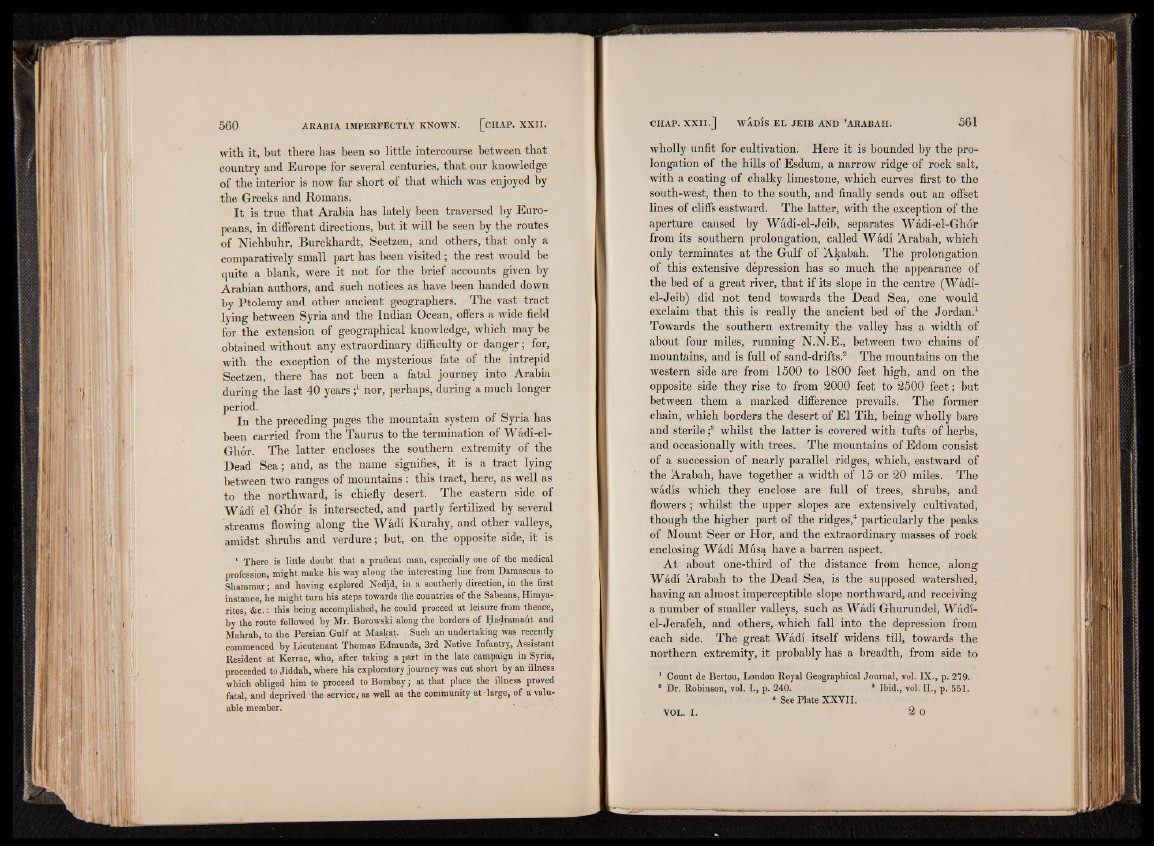
with it, but there has been so little intercourse between that
country and Europe for several centuries, that our knowledge
of the interior is now far short of that which was enjoyed by
the Greeks and Romans.
It is true that Arabia has lately been traversed by Europeans,
in different directions, but it will be seen by the routes
of Niehbuhr, Burckhardt, Seetzen, and others,'that only a
comparatively small part has been visited; the rest would be
quite a blank, were it not for the brief accounts given by
Arabian authors, and such notices as have been handed down
by Ptolemy and other ancient geographers. The vast tract
lying between Syria and the Indian Ocean, offers a wide field
for the extension of geographical knowledge, which may be
obtained without any extraordinary difficulty or danger; for,
with the exception of the mysterious fate of the intrepid
Seetzen, there has not been a fatal journey into Arabia
during the last 40 years nor, perhaps, during a much longer
period. ,
In the preceding pages the mountain system of Syria has
been carried from the Taurus to the termination of Wadi-el-
Ghor. The latter encloses the southern extremity of the
Dead Sea; and, as the name signifies, it is a tract lying
between two ranges of mountains : this tract, here, as well as
to the northward, is chiefly desert. The eastern side of
Wadi el Ghor is intersected, and partly fertilized by several
streams flowing along the Wadi Kurahy, and other valleys,
amidst shrubs and verdure; but, on the opposite side, it is
1 There is little doubt that a prudent man, especially one of the medical
profession, might make his way along the interesting line from Damascus to
Shammar; and having explored Nedjd, in a southerly direction, in the first
instance, he might turn his steps towards the countries of the Sabeans, Himya-
rites, &c.: this being accomplished, he could proceed at leisure from thence,
by the route followed by Mr. Borowski along the borders of Hadramaiit and
Mahrah, to the Persian Gulf at Maskat. Such an undertaking was recently
commenced by Lieutenant Thomas Edmunds, 3rd Native Infantry, Assistant
Resident at Kerrac, who, after taking ap a rt in the late campaign in Syria,
proceeded to Jiddah, where his exploratory journey was cut short by an illness
which obliged him to proceed to Bombay; at that place the illness proved
fatal, and deprived the service,-as well as the community at-large, of a valuable
member.
wholly unfit for cultivation. Here it is bounded by the prolongation
of the hills of Esdum, a narrow ridge of rock salt,
with a coating of chalky limestone, which curves first to the
south-west, then to the south, and finally sends out an offset
lines of cliffs eastward. The latter, with the exception of the
aperture caused by Wadi-el-Jeib, separates Wadi-el-Ghor
from its southern prolongation, called Wadi Arabah, which
only terminates at the Gulf of Akabah. The prolongation
of this extensive depression has so much the appearance of
the bed of a great river, that if its slope in the centre (Wadi-
el-Jeib) did not tend towards the Dead Sea, one would
exclaim that this is really the ancient bed of the Jordan.1
Towards the southern extremity the valley has a width of
about four miles, running N.N.E., between two chains of
mountains, and is full of sand-drifts.2 The mountains on the
western side are from 1500 to 1800 feet high, and on the
opposite side they rise to from 2000 feet to 2500 feet; but
between them a marked difference prevails. The former
chain, which borders the desert of El Tih, being wholly bare
and sterile f whilst the latter is covered with tufts of herbs,
and occasionally with trees. The mountains of Edom consist
of a succession of nearly parallel ridges, which, eastward of
the Arabah, have together a width of 15 or 20 miles. The
wadis which they enclose are full of trees, shrubs, and
flowers; whilst the upper slopes are extensively cultivated,
though the. higher part of the ridges,4 particularly the peaks
of Mount Seer or Hor, and the extraordinary masses of rock
enclosing Wadi Musa have a barren aspect.
At about one-third of the distance from hence, along
Wadi Arabah to the Dead Sea, is the supposed watershed,
having an almost imperceptible slope northward, and receiving
a number of smaller valleys, such as Wadi Ghurundel, Wadi-
el-Jerafeh, and others, which fall into the depression from
each side. The great Wadi itself widens till, towards the
northern extremity, it probably has a breadth, from side to
1 Count de Bertou, London Royal Geographical Journal, vol. IX., p. 279.
a Dr. Robinson, vol. I., p. 240. s Ibid., vol. II., p. 551.
* See Plate XXVII.
VOL. I . 2 0